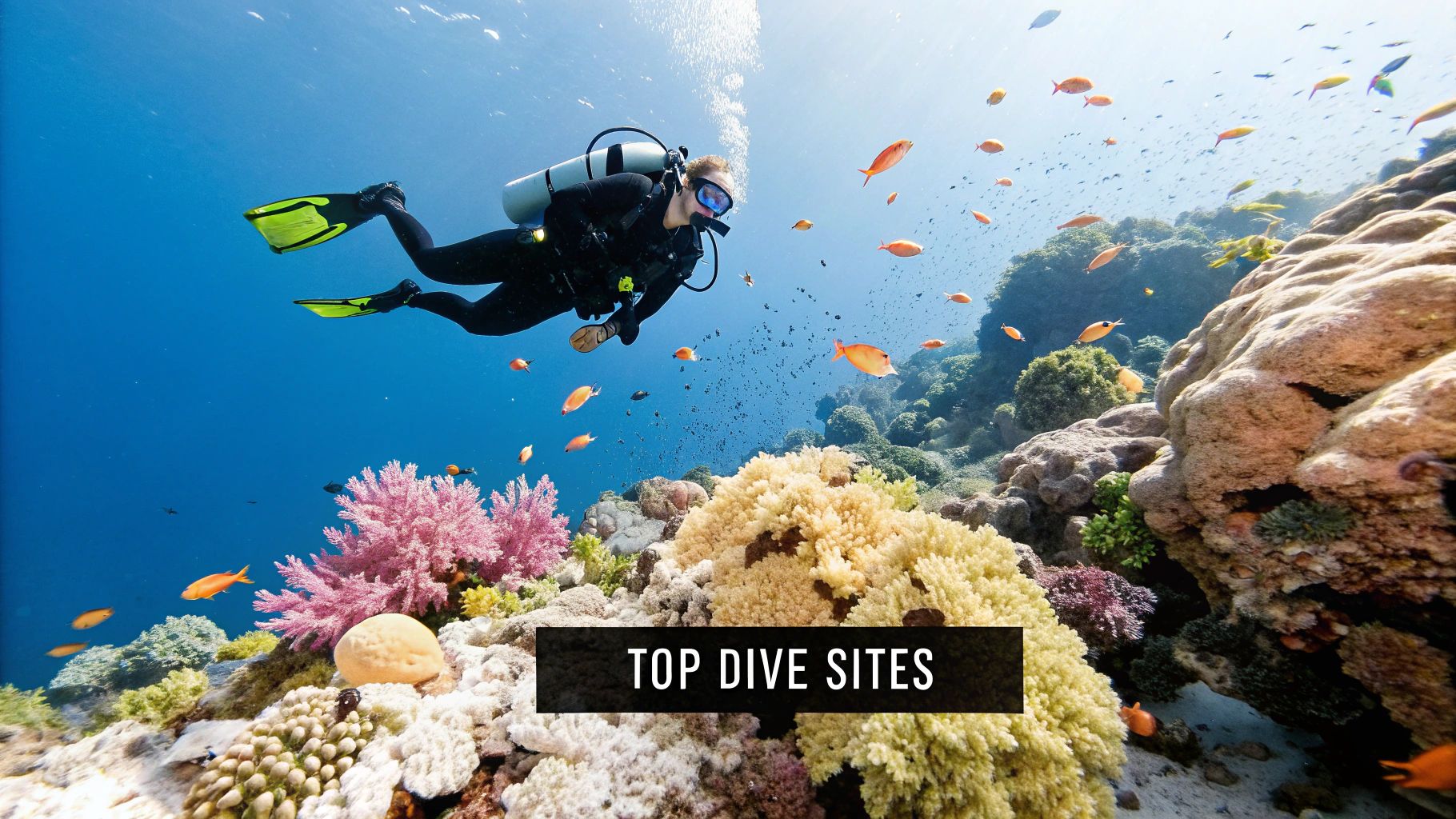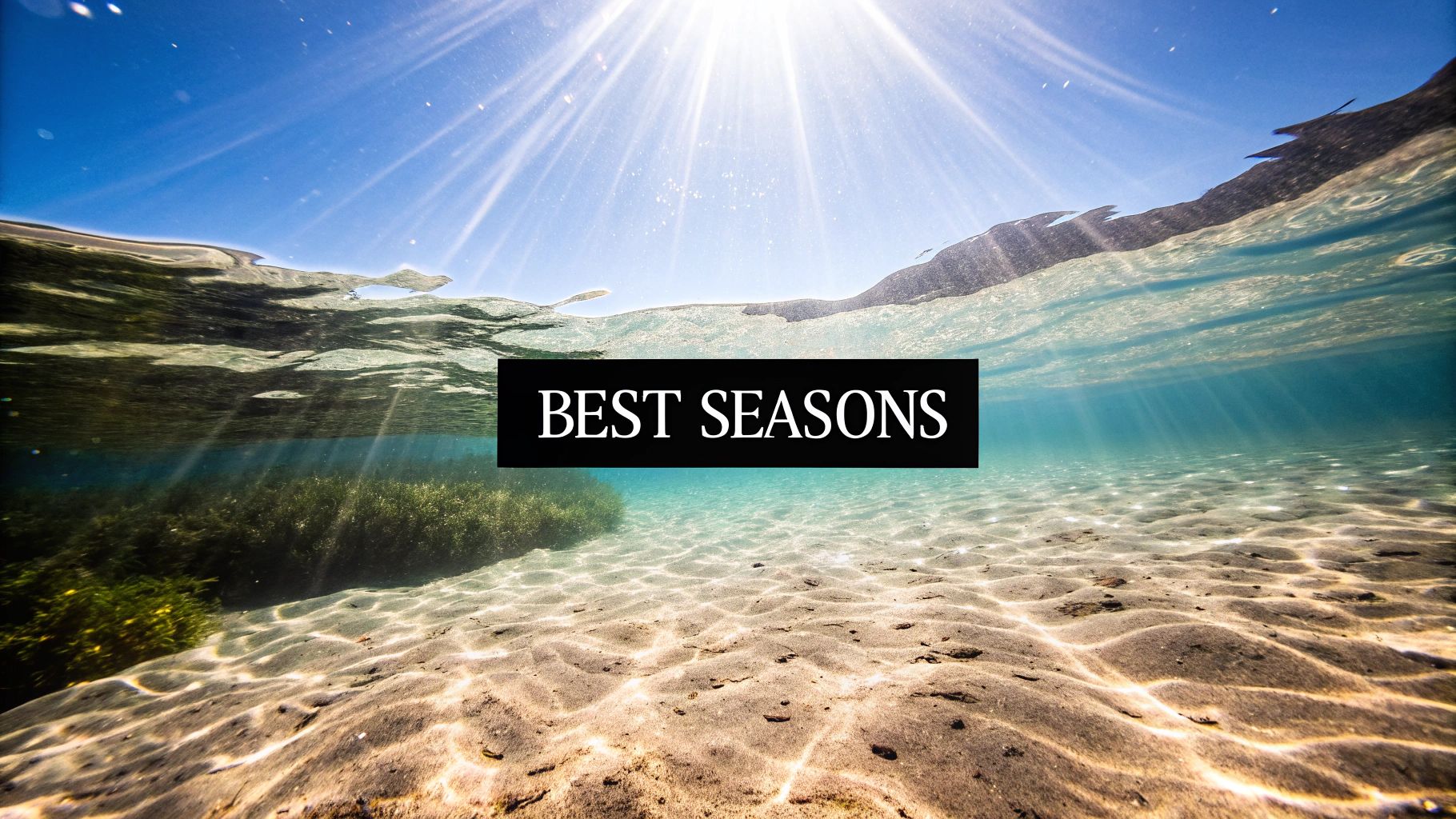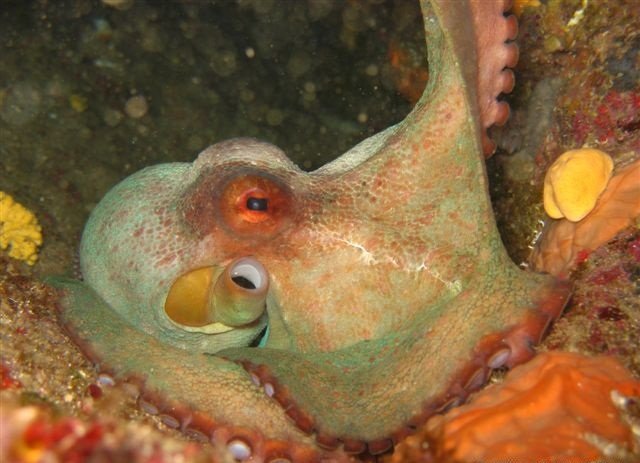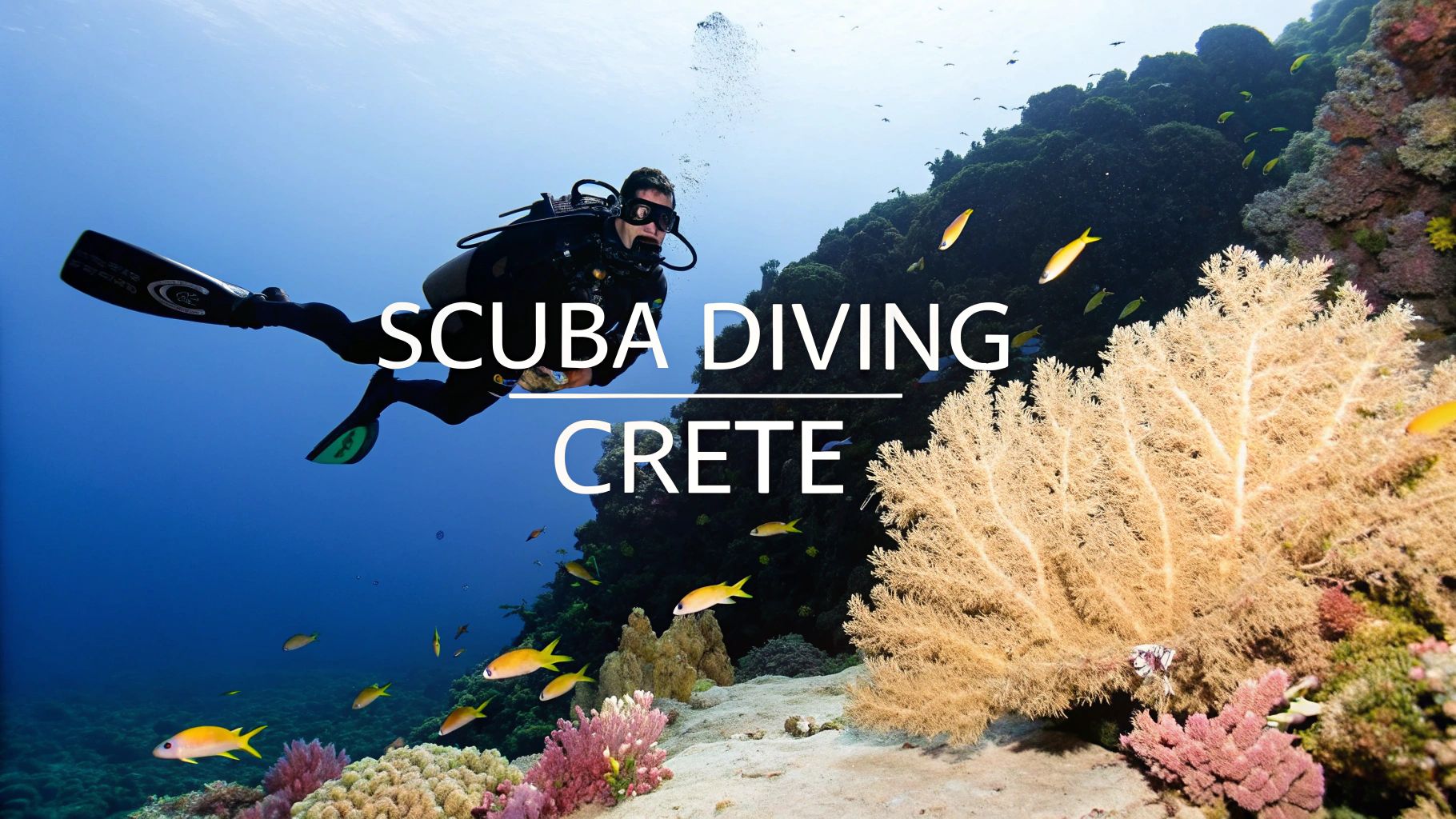Scuba diving in Crete is more than just a holiday activity; it’s an invitation to explore a spectacular underwater realm where crystal-clear waters meet ancient history. For divers of all stripes, especially those from the UK looking for a memorable adventure, Crete delivers with its superb visibility and invitingly warm sea.
Why Is Crete Such a Top-Notch Diving Destination?

The first time we took the plunge into the sea off Crete, it clicked. We instantly understood why this Greek island is one of the Mediterranean's best-kept secrets. It's not just about spotting fish; it's about being enveloped in a world where nature and history have been intertwined for thousands of years. There's a certain magic to gliding through an underwater archway, knowing it has been part of the seascape for millennia.
What really sets the island apart is its sheer variety. We could be navigating a dramatic cavern system one day and drifting over the submerged remnants of an ancient civilisation the next. This unique mix of geological wonders and historical intrigue makes for a dive trip that’s anything but ordinary. It truly has something for both the thrill-seeker and the history buff in all of us.
An Unforgettable Underwater Experience
The exceptional clarity of the water is what makes every dive so memorable. On a good day, the visibility can feel almost infinite, allowing us to appreciate the stunning underwater topography and spot marine life from a distance.
Crete caters beautifully to everyone, from those taking their very first breaths underwater to seasoned pros looking for their next challenge. The conditions are generally very welcoming, with warm water and calm seas, especially during the main season.
For us, scuba diving in Crete is about so much more than just ticking sites off in a logbook. It’s about that buzz of discovery, sharing the excitement with a dive buddy, and feeling a real connection to this ancient, submerged world.
Accessibility is another huge plus. Professional dive centres are dotted all along the coast, making it incredibly easy to sort out gear hire, guided dives, or certification courses. If you want to know more about our mission to help fellow divers, you can check out our story at WikiBubbles. This convenience means less time fussing with logistics and more time soaking up the incredible underwater scenery.
Ideal Conditions for Every Diver
Crete’s reliable diving conditions are a huge part of its appeal. The island boasts phenomenal underwater visibility, often reaching up to 30 metres (100 feet), which is fantastic by any standard.
In the summer months, water temperatures hover between a very comfortable 22°C and 26°C (72°F to 79°F). This warmth allows for long, relaxed dives without the shivers, creating a safe and inviting environment for everyone—a real treat for divers used to the cooler waters back in the UK.
Exploring Crete's Most Spectacular Dive Sites
Crete’s sprawling coastline is a diver's dream, a veritable treasure map of underwater worlds. Each region has its own distinct personality, and when we're planning a dive here, we're not just thinking about depth charts; we're thinking about the story each site tells. From the dramatic caves near Chania to the secluded bays of the south coast, every descent feels like opening a new chapter.
The smartest way to tackle scuba diving in Crete is to plan your trip by region. It cuts down on travel time and lets you really sink into the unique underwater landscapes each part of the island has to offer. We've organised our favourite spots this way to help you build the perfect dive log.
This image gives you a glimpse of the incredible encounters you can have while exploring the waters around the island.

There's nothing quite like a close encounter with a sea turtle, a sight that’s thankfully common in Crete's protected marine areas.
Chania: The Dramatic Western Coast
The Chania region, out on the western coast, is famous for its breathtaking caves and dramatic underwater architecture. Dives here feel like we’re dropping into a mythical underworld, where light and shadow dance across ancient rock formations. It’s a photographer’s paradise and an absolute must for any diver with a taste for adventure.
One of our all-time favourite dives is the Elephant Cave. As we descend into its submerged entrance, the sheer scale of the cavern hits us. Inside, the water is perfectly still, and the light filtering from the entrance creates an ethereal blue glow, lighting up spectacular stalactites and stalagmites. The cave gets its name from the fossilised remains of an extinct elephant species found deep inside, which adds a whole layer of prehistoric wonder to the experience.
Another standout near Chania is the Lighthouse Wall. This is a fantastic wall dive that plummets into the deep blue. We love the feeling of drifting along that vertical face, peering into crevices for moray eels and octopuses. The top of the reef is a bustling city of smaller fish, making it a vibrant and dynamic dive from the safety stop right down to the bottom.
Rethymno: Caves and Canyons
Heading east, the area around Rethymno offers a completely different underwater playground, one defined by intriguing canyons and swim-throughs. The geology here has carved out a natural maze for divers, with passages that open up into hidden chambers and light-filled grottos.
The Blue Hole near Rethymno is a local classic we find ourselves returning to again and again. It's not a deep vertical shaft like its famous namesakes; instead, it's a beautiful cavern system. We enter through a large opening in the reef top and drop into a huge chamber where beams of sunlight pierce the darkness. The effect is truly magical.
If you enjoy weaving through intricate rock formations, The Arches is an exceptional site. We get to navigate a series of natural archways and tunnels, each one decorated with colourful sponges and soft corals. It feels like we’re exploring a submerged cathedral, and that sense of discovery around every corner is what makes this dive so special. To see how these sites compare to others around the globe, check out our comprehensive guide to global dive destinations.
Heraklion: The Central Hub
The central region of Heraklion isn't just Crete's busy capital; it's also the gateway to some incredibly diverse diving. The sites here run the gamut from gentle, colourful reefs perfect for new divers to deeper, more challenging spots for the more experienced.
The Dia Island dive sites, just a short boat ride from Heraklion, are a real highlight. This protected islet serves up pristine conditions and an absolute abundance of marine life. When we dive here, we're often met by huge schools of damselfish and bold, curious groupers. The visibility is usually outstanding, giving you those stunning wide-angle views of a truly healthy reef.
Another important spot is the Messerschmitt Wreck, the remains of a German fighter plane from the Second World War. Resting at around 24 metres, the wreck is an atmospheric and poignant dive. Swimming around the fuselage and wings is a powerful reminder of the island's history, now reclaimed by the sea and providing a home for all sorts of marine creatures.
Crete's Premier Dive Sites at a Glance
To help you get a quick overview, we’ve put together this table comparing some of the top dive sites across the island. It’s a handy way to see what each location offers and which ones might be the best fit for your logbook.
Dive Site Name | Location (Near) | Best For | Max Depth | Experience Level |
|---|---|---|---|---|
Elephant's Cave | Chania | Cavern diving, unique geology | 20m | Advanced |
Lighthouse Reef & Wall | Chania | Wall diving, marine life | 30m+ | All Levels |
The Blue Hole | Rethymno | Caverns, light effects | 18m | Intermediate |
The Arches | Rethymno | Swim-throughs, rock formations | 22m | Intermediate |
Dia Island | Heraklion | Healthy reefs, high visibility | 25m | All Levels |
Messerschmitt Wreck | Heraklion | Wreck diving, history | 24m | Advanced |
This is just a snapshot, of course. Each of these sites has its own unique character that you can only truly appreciate once you're in the water.
Ultimately, it’s the sheer variety that makes diving in Crete so rewarding. One day we could be exploring the haunting beauty of a cavern, the next we're marvelling at the vibrant life on a sun-drenched reef. The island’s underwater world never fails to deliver a genuine sense of wonder and adventure.
Discovering Crete's Underwater Inhabitants

The real magic of scuba diving in Crete happens the moment you leave the sun-drenched world above and slip into the bustling, blue world below. It’s not just about the gear or the depth; it's about those personal, eye-to-eye encounters with the locals. Every creature, from the tiniest nudibranch to a hulking grouper, adds to the story of the dive.
Dropping beneath the surface here often feels like we've been let in on a wonderful secret. We've lost count of the times we've watched shimmering clouds of damselfish dance over the reefs. Their vibrant, almost electric energy is the perfect welcome to the sheer diversity of life thriving in these Mediterranean waters.
But those first moments are just the curtain-raiser. Once you learn to slow down, to really look, that's when the unforgettable encounters happen. It’s those quiet, patient observations that turn a great dive into a truly exceptional one.
The Masters of Camouflage
The rocky seabeds and craggy walls around Crete are the perfect hunting ground for some of the ocean's most intelligent and elusive characters. We'll never forget our first octopus sighting. We were peering into a crevice when, all of a sudden, a patch of rock seemed to ripple, shift colour, and unfold into the unmistakable shape of a common octopus.
These creatures are absolute artists of disguise, and spotting one feels like a genuine achievement. They can melt into their surroundings so perfectly that finding them is a prize for any observant diver.
Another champion of hide-and-seek is the scorpionfish. We’ll often find them resting completely motionless on a ledge, their mottled, lumpy skin making them look like just another algae-covered rock. They are the ultimate ambush predators, patiently waiting for their next meal to swim by, completely unaware.
Reef Residents and Passing Visitors
As we drift over the swaying posidonia seagrass meadows and rocky ledges, we start to recognise the regulars. The dusky grouper is one of the most impressive. Seeing one of these big, powerful fish emerge slowly from a cave is a sight that commands respect and always reassures us that the ecosystem is healthy.
Of course, it's not just the big guys that make a dive memorable. Here are a few of the characters we meet on almost every trip:
Moray Eels: Peeking their heads out from a rocky lair, morays are a common but always thrilling find. You'll see them opening and closing their mouths to push water over their gills, which looks a bit menacing but is just how they breathe.
Parrotfish: These are the reef's colourful gardeners. You can often hear their distinctive crunching sound before you see them, as they use their beak-like mouths to scrape algae off the rocks.
Loggerhead Sea Turtles (Caretta caretta): A turtle sighting is never guaranteed, but when it happens, it’s pure magic. We've had some incredible moments watching these gentle giants glide effortlessly past us into the blue.
The key to truly great diving is learning to appreciate the whole ecosystem, not just chasing the "big ticket" animals. It’s the intricate dance between predator and prey and the explosion of life you find in every nook and cranny that makes the underwater world so endlessly fascinating.
The World of Macro Wonders
Look past the bigger fish, and you'll find a miniature universe teeming with life. For anyone with a patient eye for detail, the macro life in Crete is spectacular. Getting your nose close to the reef reveals a whole cast of tiny, bizarre, and colourful characters that most divers swim right past.
We’ve spent the better part of a dive completely mesmerised by a flamboyant nudibranch—a sea slug—making its slow, deliberate way across a sponge. They come in an unbelievable array of colours and patterns, like tiny, living works of art. Finding a perfectly hidden blenny, with just its comical face peeking out from a tiny hole, never fails to make us smile.
This is where slowing down really pays off, revealing a hidden layer of beauty that makes the Cretan sea so special.
Planning Your Trip: The Best Time to Dive
Timing really is everything when you're planning a dive holiday, and this is especially true for Crete. The island offers a wonderfully long dive season, but knowing the subtle differences from month to month can make all the difference, ensuring every dive is as comfortable and spectacular as possible. Having dived here all through the season, we can tell you that each period brings its own unique character to the underwater world.
The main window for diving opens around April and stays wide open right through to late October, sometimes even nudging into early November. This is one of Crete's biggest draws—plenty of flexibility. The right time for you will really boil down to what you prefer in terms of water temperature, topside weather, and how many other divers you want to share the view with.
Peak Season: Summer Diving
July and August are the heart of the Cretan summer, and this is when the diving scene is absolutely buzzing. Personally, we love this time of year because the sea is at its warmest, often hitting a gloriously balmy 26°C (79°F). That kind of warmth means you can often get away with just a 3mm shorty, which gives you incredible freedom of movement in the water.
Visibility during these peak months is usually phenomenal, often pushing past the 30-metre mark. The combination of calm, crystal-clear water and bright overhead sun makes the colours of the reefs and marine life just pop. The trade-off, of course, is that this is also peak tourist season, both on land and under the waves.
From our experience, if you're planning a trip for July or August, you absolutely must book your dives well in advance. The most popular dive centres and famous sites get filled up fast, so a bit of forward planning means you won't miss out.
Shoulder Seasons: Spring and Autumn

For a lot of seasoned divers, the shoulder seasons—spring (April to June) and autumn (September to October)—are the real sweet spot for diving in Crete. During these months, the weather on land is beautifully warm without the blistering heat of mid-summer, and the tourist crowds have thinned out nicely.
In the spring, the water is on the rise, starting at a brisk 17°C (63°F) in April and climbing steadily. We’ll typically wear a 5mm full wetsuit then to stay perfectly comfortable. You get a real sense of the underwater world waking up, with marine life becoming more active as the temperatures increase.
But autumn… autumn is probably our favourite time to be here. The sea holds onto its summer warmth, often staying above 22°C (72°F) well into October, but the beaches and dive boats are so much quieter. It's a fantastic combination of warm water and peaceful conditions, creating a wonderfully relaxed atmosphere. Visibility is still excellent, and you often feel like you have the whole underwater world to yourself.
What Wetsuit to Pack
Choosing the right exposure suit is the key to a comfortable dive. It all depends on when you visit and your own personal thermostat. Over the years, we've found these guidelines work well for most people.
April - May: The water is warming up from 17-20°C (63-68°F). A 5mm or even a 7mm full wetsuit is a good shout to make sure you stay warm, especially if you're doing deeper dives or multiple dives in a day.
June - September: This is prime time for warm water, typically sitting between 22-26°C (72-79°F). Most divers will be perfectly happy in a 3mm shorty or a 3mm full wetsuit.
October - November: As the season winds down, the water is cooling but still pleasant, around 20-23°C (68-73°F). We find a 5mm full wetsuit is the ideal choice to stay comfortable.
Ultimately, the "best" time for your trip comes down to what you're after. If you want the warmest water possible and a lively holiday vibe, summer is for you. But if you'd rather have quieter dive sites and more temperate weather, the incredible conditions in spring and autumn are truly hard to beat.
How to Choose the Right Dive Centre in Crete
Choosing your dive centre is probably the single most important decision you'll make for your scuba holiday in Crete. Think of them less as a service provider and more as your underwater partner for the trip. A great operator is the difference between a few forgettable dives and an experience you'll be talking about for years.
The whole vibe of a dive operation starts the moment you step through the door. Is the team genuinely happy to see you? Do they patiently answer all your questions, or are you just another customer being pushed through the system? For us, clear, unhurried communication is a must. It's the foundation of a safe and enjoyable dive.
First Impressions: Credentials and Kit
Before we even think about booking, the first port of call is checking their credentials. Look for affiliations with globally recognised training agencies like PADI (Professional Association of Diving Instructors) or SSI (Scuba Schools International). These logos aren't just for show; they signify that the centre adheres to strict international standards for training and safety.
Next up, a quick inspection of the rental gear. You don't need to be an equipment technician to get a feel for things. Is the kit room tidy and organised, or does it look like a jumble sale? Check for obvious signs of neglect on the regulators, BCDs, and wetsuits – things like cracked hoses or significant frays. Good kit is a non-negotiable.
A dive centre's attitude towards its equipment is often a direct reflection of its attitude towards your safety. If the gear looks tired and neglected, it's a clear signal to walk away and find another operator.
Reading Between the Lines: Safety and Group Sizes
Look beyond the paperwork and assess the centre’s safety culture. One of the biggest indicators for us is the instructor-to-diver ratio. We always favour operations that keep their groups small. It means you get more personalised attention and your guide can properly supervise everyone in the water. Big, crowded dives often feel rushed and can quickly become a safety concern.
A fantastic benchmark for what to look for is the Crete Underwater Center in Agios Nikolaos. They're well-regarded for a reason, with 30 sets of state-of-the-art gear, a proper boat that gets you to over 25 local dive sites, and multilingual PADI instructors. It's a professional setup from top to bottom.
If you want to brush up on your theory before you go, feel free to dive into our comprehensive scuba diving guides for more in-depth articles.
The Value of Local Know-How
Finally, remember that you’re not just renting tanks and weights; you're tapping into a wealth of local knowledge. Chat with the instructors and guides. Ask them what they love about diving there, what their favourite sites are, and what you're likely to see.
Their passion for the local underwater environment is what turns a standard dive into something truly special. A great guide will know exactly where that elusive octopus likes to hang out or how to navigate a swim-through for the best light. This insider knowledge is priceless and the real secret to having an incredible time diving in Crete.
A Smart Diver is a Safe Diver in Crete
Let's be honest, the best dives are the ones where you can completely lose yourself in the moment, without a worry in the world. And that level of relaxation doesn't come from luck; it comes from making safety your second nature long before you even hit the water. It’s all about preparation.
Every great dive in Crete starts with a solid plan. This isn’t just for a PADI course, it’s for every single time you gear up. You and your buddy need to be on the same page about the site, your maximum depth, how long you'll be down, and what hand signals you'll use. Think of it as your underwater game plan.
The Pre-Dive Checklist
Before you take that giant stride, run through your gear checks meticulously. The old BWRAF acronym (BCD, Weights, Releases, Air, Final OK) is a classic for a reason—it works. Doing this with your buddy isn't just a formality; it's the final handshake that confirms you're both ready and your equipment is good to go.
And speaking of your buddy, they are your most important piece of gear. Stick together. Close enough to make eye contact and help in an instant. You're a team, looking out for each other, which makes the entire experience safer and way more fun.
What to Watch for in Cretan Waters
Crete’s underwater environment has its own character, and it pays to know what to expect. During the high season, the surface can get busy with boat traffic. That’s why deploying a Surface Marker Buoy (SMB) on your ascent is non-negotiable. It makes you visible to anyone up top.
Currents can also make an appearance at some sites. Your dive guide will give you the full briefing, so listen carefully. If you do find yourself in a current, don't try to fight it. Go with it, stay calm, and signal your guide if you need help.
Diving is an incredibly safe sport, but the one thing that can get you into trouble is complacency. It's the experienced, disciplined divers who stick to the rules every time that avoid preventable problems. This holds true whether it’s your tenth dive or your thousandth.
Your Crete Diving Questions Answered
To wrap things up, let's tackle some of the questions we hear all the time about diving in Crete. Think of this as a quick-start guide to clear up those last-minute queries before you take the plunge.
Do I Need a Dive Certification to Try It?
For the vast majority of dives, yes, you'll need to show a certification card like a PADI Open Water or something similar. But if you’ve never even tried it before, you’re in luck.
Pretty much every dive centre on the island offers a "Discover Scuba Diving" experience. It’s a brilliant way to get a taste of the underwater world under the watchful eye of an instructor, all without signing up for a full course. We’ve found it’s how most people get hooked!
What's the Minimum Age to Dive?
Generally, the minimum age to try a proper scuba experience is 10 years old.
For the younger ones, kids aged 8 and 9 can often join a "Bubble Maker" program. This is a super safe, fun introduction that takes place in a swimming pool or a very calm, shallow bay. It's more about getting them comfortable and excited about breathing underwater than anything else.
Are There Dangerous Sea Creatures I Should Worry About?
Honestly, the marine life around Crete is incredibly safe. You'll likely see some fascinating critters like moray eels tucked into rocks or well-camouflaged scorpionfish, but they are not aggressive.
The golden rule of diving always applies: look, but don't touch. As long as you give the animals their space and observe respectfully, you’ll have no issues at all. It’s their home, after all.
Ready to discover your next underwater adventure in Crete or beyond? Join the community at WikiBubbles and explore the world's best dive sites with insights from fellow divers. Start planning your perfect dive today at https://wikibubbles.com.

